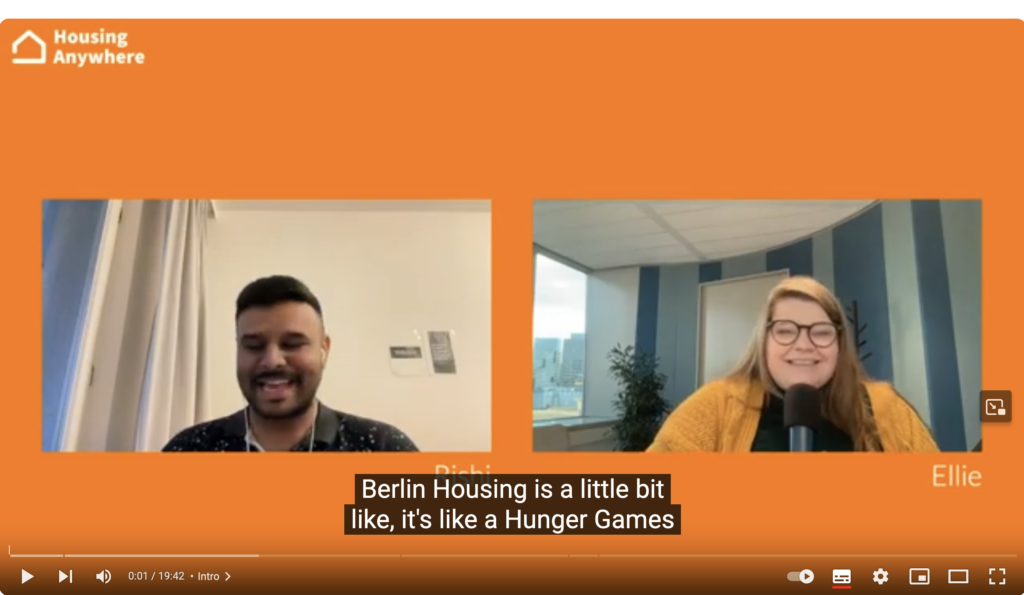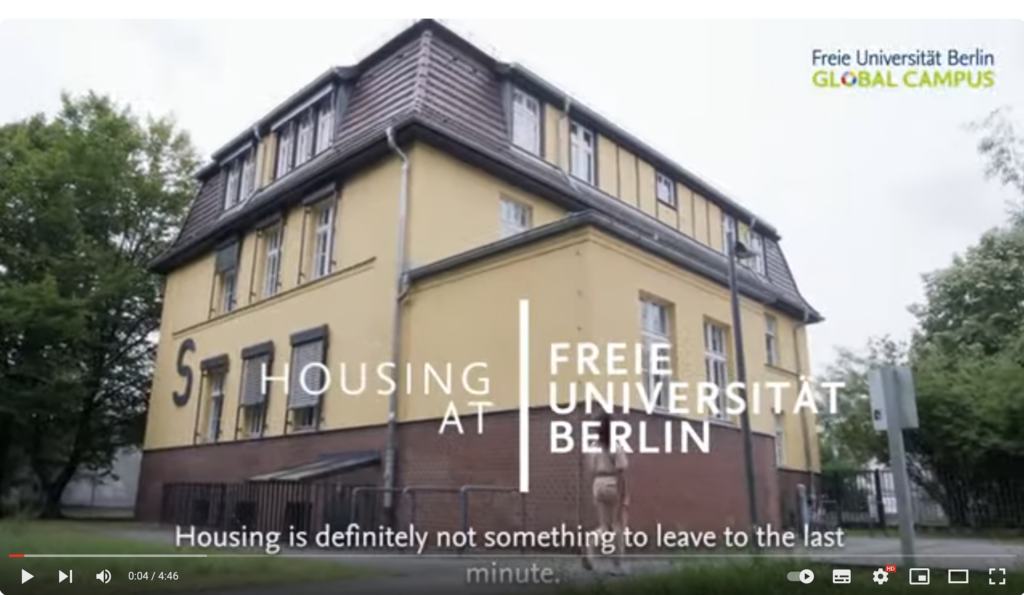Studentische Wohnungsnot in Berlin
von Nadja-Christina Schneider1
Für Studierende wird es in einer Stadt wie Berlin seit Jahren immer schwieriger, eine bezahlbare Unterkunft zu finden. Lange Wartelisten für Wohnheimplätze, die WG-Zimmersuche als herausfordernder Casting-Wettbewerb und für viele kaum bezahlbare Mieten. Wohnen „außerhalb“ ist bekanntlich keine attraktive Alternative für junge Menschen, die es in dieser besonders prägenden Phase ihres Lebens in die Großstadt zieht. Lange Anfahrtswege, eine mitunter schlechte Anbindung an öffentliche Verkehrsmittel und das Fehlen anderer wichtiger Infrastrukturen des täglichen Lebens möchten viele ebenfalls nicht in Kauf nehmen. Inmitten der allgemeinen Wohnungsnot in Berlin fange „die studentische Wohnungskrise erst an“, so formulierte es der Tagesspiegel am 22. Dezember 2022.
Wie David Madden und Peter Marcuse in ihrem gemeinsam verfassten Buch In Defense of Housing (2016) kritisieren, vermittelt der vielzitierte Begriff der Wohnungskrise, dass es sich lediglich um eine temporäre Abweichung von einem ansonsten weitaus besseren Normalzustand handele, der mit den richtigen Maßnahmen wiederhergestellt werden könnte, wie es insbesondere die politische Rhetorik nahelegt.2[1] Madden und Marcuse erinnern jedoch daran, dass bereits Friedrich Engels in seinen Überlegungen zur Wohnungsfrage (1887) erkannt hatte, für welche gesellschaftlichen Gruppen diese „Krise“ zu allen Zeiten tatsächlich den Normalzustand darstellt:
„The so-called housing shortage, which plays such a great role in the press nowadays, does not consist in the fact that the working class generally lives in bad, overcrowded or unhealthy dwellings. This shortage is not something peculiar to the present; it is not even one of the sufferings peculiar to the modern proletariat in contradistinction to all earlier oppressed classes. On the contrary, all oppressed classes in all periods suffered more or less uniformly from it (F. Engels (1872). The Housing Question, zitiert in Madden & Marcuse 2016: 9).”
Die neue Wohnungsfrage im Berlin des 21. Jahrhunderts ist in den sog. klassischen Medien durchaus sichtbar, aber es fällt schnell auf, welche gesellschaftlichen Gruppen keine besonders hohe mediale Aufmerksamkeit erhalten. Studierende gehören ohne Zweifel dazu, denn abgesehen von einigen Schlagzeilen und Zeitungsberichten, welche regelmäßig zum Semesterbeginn zu finden sind, hält sich die Berichterstattung zur studentischen Wohnungsnot in der deutschen Hauptstadt in Grenzen.
Woran könnte das liegen, zumal in einer Stadt, die sich als „engagierte, exzellente und internationale Brain City“ beziehungsweise als „innovative Wissensmetropole“ versteht und in der es in der Tat eine beachtliche Zahl an öffentlichen und privaten Universitäten sowie Hochschulen gibt? Nach Angaben der Berliner Senatsseiten forschen, lehren, arbeiten und studieren „an den elf staatlichen, zwei konfessionellen und rund 30 staatlich anerkannten Hochschulen in Berlin über 250.000 Menschen aus aller Welt.“3[2] Wie finden all diese Hochschulangehörigen ihren bezahlbaren Wohnraum in Berlin und wo wohnen sie?
Auch ein Blick auf die zentralen Webseiten der drei großen Berliner Universitäten TU, HU und FU weist das Thema studentisches Wohnen und die Wohnungsnot der Studierenden nicht als eines aus, für das sich die Bildungseinrichtungen selbst in zentraler Verantwortung sehen oder über das sie sonderlich viel zu berichten hätten. Die wenigen auffindbaren Informationen richten sich vorwiegend an internationale Studierende oder verweisen auf die Angebote des Studierendenwerks bzw. im Fall der HU auf den Campus in Adlershof. Wie Judith Thomsen in ihrer Studie zu „Home Experiences in Student Housing“ (2007) mit Bezug auf Norwegen erwähnt, werden Unterkünfte für ihre Studierenden nicht nur in Deutschland, sondern auch in Skandinavien traditionell nicht als Bereich betrachtet, für den die Universitäten als verantwortlich gesehen werden. Sie führt jedoch Großbritannien als Beispiel für einige westeuropäische Länder an, in denen „university-provided student housing“ zumindest über längere Zeiträume existierten (Thomsen 2007: 578).
Da studentisches Wohnen in Berlin offenbar weiterhin als ein Bereich betrachtet wird, der buchstäblich „außerhalb“ der Universität liegt, müssen Studierende selbst eine Lösung hierfür finden. Gelingt es nicht, wird dies von jungen Menschen häufig als „Scheitern“ oder ungewollte Rückkehr in die Phase der Adoleszenz wahrgenommen. Besonders deutlich wurde dies in der Pandemie-Situation, in der sich Studierende in hoher Zahl gezwungen sehen, wieder bei ihren Eltern und vielfach in ihr altes Kinderzimmer einzuziehen, das nach ihrem Auszug eigentlich für ihre Wochenendbesuche oder andere Zwecke genutzt werden sollte. Für viele Studierende auf Wohnungssuche in Berlin, darunter ein hoher Anteil an internationalen Studierenden, gab und gibt es jedoch nicht einmal diese Option eines „Zurück zu…“ oder sie versuchen, den Wegzug aus der Stadt, in die sie mit so vielen Hoffnungen und Erwartungen gekommen sind, doch noch irgendwie abwenden zu können. Es ist ein sehr wichtiger Schritt, dass wir an den Berliner Universitäten mittlerweile immer mehr Bewusstsein und auch Angebote für zentrale Fragen der mentalen Gesundheit von Studierenden bereitstellen. Doch wir verknüpfen diese bislang noch nicht mit der außerordentlich hohen Belastung, der sie in vielen Fällen in erster Linie aufgrund ihrer Wohnsituation und finanziellen Probleme und möglicherweise nicht primär durch ihr Studium ausgesetzt sind.
Im deutlichen Kontrast zur Abwesenheit der Wohnungsnot von Studierenden in den „klassischen“ Medien weisen soziale Medien und Plattformen wie YouTube neuerdings eine wachsende Zahl an hochgeladenen Beiträgen zu diesem Thema auf. Darin lassen sich wiederum unterschiedlichste Formate und damit verknüpfte Medienpraktiken feststellen, welche von einer medialen Selbstpräsentation der Studierenden und Thematisierung ihrer aktuellen Wohnsituation oder verzweifelten Suche über dialogische Formate und Tipps für andere Studierende bis zu einfach hochgeladenen Videos mit Informationen und Testimonial-Berichten reichen können. Auffallend ist auch hier, dass sich viele der Austausch- und Informationsangebote gezielt an internationale Studierende in Berlin richten.
Home Abroad Podcast: Student Accommodation in Berlin
Rishi: „Berlin Housing is a little bit like a Hunger Games.”
Ellie: “Hahaha. Fight to the death for it.”
Eines der am häufigsten aufgerufenen Beispiele hierfür ist ein knapp fünfminütiges Video, das für internationale Studierende an der Freien Universität produziert wurde und sich überwiegend auf studentische Unterkünfte im Südwesten Berlins bezieht. Neben Studentenwohnheimen und der Unterbringung in Gastfamilien sowie einem kurzen Abstecher an den Alexanderplatz zum kommerziellen The Social Hub (früher The Student Hotel) wird hier das Studentendorf Schlachtensee vorgestellt, nach dessen Vorbild für HU-Studierende das Studentendorf Adlershof neu erbaut wurde. Die interviewte Bewohnerin im FU-Video verrät uns, dass heute überwiegend internationale Studierende im Studentendorf in Schlachtensee ihre temporäre Unterkunft in Berlin finden – ursprünglich errichtet wurde es in der Nachkriegszeit jedoch nicht nur, um dort Studierende der FU unterbringen zu können, sondern auch, um im Rahmen der US-amerikanischen Maßnahmen zur Reeducation junge Menschen in der Bundesrepublik an die Demokratie heranzuführen.
Die Architektur und Raumplanung des Studentendorfes Schlachtensee sollte also dafür Sorge tragen, dass junge Studierende als zentrale Akteursgruppe der bundesdeutschen Nachkriegsgesellschaft lernen, demokratisch zusammen zu leben. Dies mag aus heutiger Sicht als Form eines „social engineering“ und Ausdruck einer top-down-Planung kritisch betrachtet werden. Gerade mit Blick auf den „hyperkommodifizierten“ städtischen Wohnungsmarkt der Gegenwart (Madden & Marcuse 2016: 39) wirft es aber auch die Frage auf, wie die Gesellschaft und Politik eigentlich heute auf die Studierenden und ihre Rolle blickt, und ob sie nicht nur für die Notwendigkeit des studentischen Wohnens erneut sensibilisiert werden könnte, sondern vor allem auch für das positive Potenzial gemeinschaftlichen Wohnens als Erfahrung und eingeübte Praxis, die zu Formen eines gutes Zusammenleben in der Gesellschaft beitragen kann.
Zitierte Literatur
Madden, David and Peter Marcuse (2016). In Defense of Housing. London/New York: Verso.
Thomsen, Judith (2007). “Home Experiences in Student Housing: About Institutional Character and Temporary Homes”. Journal of Youth Studies, 10:5, 577-596.
Über die Autorin
Nadja-Christina Schneider ist Südasienwissenschaftlerin und arbeitet am Institut für Asien- und Afrikawissenschaften. Mit dem Thema bezahlbarer Wohnraum, Architektur und Zusammenleben befasst sie sich seit einigen Jahren intensiver.
- Dieser Text ist aus einer gemeinsamen Schreibübung mit Master-Studierenden hervorgegangen, die wir im Sommersememster 2023 zum Thema studentisches Wohnen, Zusammenleben und bezahlbarer Wohnraum in Berlin im Rahmen eines Seminars durchgeführt haben. Der ebenfalls in diesem Blog veröffentlichte Beitrag von İnci Nazlıcan Sağırbaşbaş zum Thema „Making a Home in Berlin: Navigating a Housing Crisis as an International Student“ ist auch aus dieser Schreibübung im Rahmen unseres Seminars hervorgegangen. ↩︎
- „Klara Geywitz, Bundesministerin für Wohnen, Stadtentwicklung und Bauwesen: ‚Zum ersten Mal gibt es im Rahmen des sozialen Wohnungsbaus ein Förderprogramm nur für junge Menschen in Ausbildung. Sie sollen sich vor allem auf ihre Ausbildung konzentrieren und nicht wochen- oder gar monatelang auf Wohnungssuche sein. Mit einer halben Milliarde Euro können die Länder jetzt Wohnheimplätze neu- oder umbauen, um junge Menschen in die Region zu holen oder zu halten. Damit wird der Standort Deutschland insgesamt attraktiv für junges Knowhow, aber auch die einzelnen Regionen profitieren erheblich. Wer einmal da ist, bleibt vielleicht. Wie gut man Wohnraum findet, den sich jeder leisten kann, ist dabei ein entscheidender Faktor. Mit diesem gezielten Fokus auf Junges Wohnen werden wir sicher schnell Erfolge erzielen‘ („Bezahlbarer Wohnraum für junge Menschen: Sonderprogramm Junges Wohnen gestartet!“ https://www.studentenwerke.de/de/content/bezahlbarer-wohnraum-fue-junge-menschen).“ (10.06.2023) ↩︎
- Senatsverwaltung für Wissenschaft, Gesundheit und Pflege: Wissenschaft und Forschung: Hochschulen. https://www.berlin.de/sen/wissenschaft/einrichtungen/hochschulen/ (10.06.2023). ↩︎
By İnci Nazlıcan Sağırbaşbaş
Regardless of our backgrounds, the concept of home is central to our belonging, it is a matter of feeling comfortable and safer. While the emerging housing crisis in Berlin results in a massive housing shortage, high rent prices, informal housing arrangements, and unjust rental procedures for almost everyone, it adds to the vulnerability of international students who are already in discriminatory and structurally challenging processes. Newly arrived international students are bound to go through various difficulties in finding a relatively stable or affordable place while also struggling with the barriers of language, law, and bureaucracy. They have to constantly navigate the various stereotypes ingrained in people’s minds, while not having the possibility of having a permanent place to live or basic utilities such as ‘a possibility of Anmeldung’.
I want to talk in particular about the experiences of finding a home in Berlin through online portals and the perceptions of the city for some international students through their various practices of home-making. How do these practices of ‘making a home’ such as finding an accommodation, settlement, building support networks, and dealing with the bureaucracy outline and influence the sense of belonging in the city? The process supporting this essay comprises auto-ethnographic research and semi-structured in-depth interviews with a homogeneous sample of international students. The following questions were asked according to the way conversations proceed: What were the biggest obstacles for you in finding housing? How did the process make you feel? What help did you get? How do you think your identity as an immigrant and a student has affected the outcomes? In total, 8 people were interviewed, 6 women and 2 men, all non-EU citizens and from middle-upper classes. The interviews provided limited data on personal and collective behaviors and trajectories while considering the complexity of the relationship between the immigrant’s experience in the city and the role of home-making.
‘While I was looking for an apartment I sent hundreds of messages without any reply, however when my partner with her German last name sent a few messages she got several replies and that’s how we found our first place.’
I, like most of my fellow international students, have looked at and applied to countless flatshares during my first months in Berlin. It became an automatic act to check new offers, answer questions, and send motivational, desperately positive, and personal messages to complete strangers on a daily basis. It was the first thing I did in the morning and the last in the evening. There were several identities crashing into each other in my mind, and I was struggling to describe who I was for the prospective flatmates who were so confident in their attempts to categorize us. With one short paragraph or two, we needed to build trust, find the correct length, and leave a positive memory. The pressure this task creates is overwhelming and non-ending. But, we were actively and collectively forming solidarities and making Berlin our home while we were searching for the houses that would contain our bodies and lives. The collectivity of the struggle and the humor that surrounded this practice of looking for a home in Berlin was one of the few things that made the anxiety of being without a stable place better.
‘The feeling that Berlin is full of immigrants also makes me feel like I’m not the only one in the same situation.’
The portals like ‘wg-gesucht’ are constantly building a collective memory of the housing crisis in Berlin which is steadily getting worse in the last couple of years. But after the months we spent on those websites and finally finding a flat in Berlin, what else does this experience teach us? What do we gain and lose, create and waste with all the time and effort we put into this? The main findings of the interviews showed that people from similar backgrounds or ethnicities were creating the main support systems and ‘arrival structures’ for the newcomers such as the established diaspora, old colleagues, or friends of friends. As well as more anonymous sources such as Reddit threads and Facebook, WhatsApp, or Telegram groups. These informal and mostly online practices were elements almost everyone utilized.
The last-minute changes and fast-paced nature of searching for a home in Berlin made it into a side job for most of us. We created fluid identities around requirements like a vegan diet, undying love of techno music, or open-door rules while the prospective flatmates were trying to navigate through the flood of hundreds of applications. We felt isolated, rejected, and without a community after hundreds of tries without getting any answers back while they were feeling confused, overwhelmed, and guilty. We were stuck in a type of “permanent temporariness” (Steigemann & Misselwitz, 2020) marked by uncertainty and exclusion as the outcomes of neo-liberal politics in Berlin. Maybe because we were privileged with our middle-upper class backgrounds and student identities, we all found a way to stay in Berlin. Now, when I asked ‘How do you feel about it now?’ to the interviewees, the memories of anxiety and stress faded into funny stories and anecdotes. But, even though the memories are almost always subjective, situated, and temporal, it doesn’t mean they are any less valuable.
‘Having some friends here and knowing the language helped me. Since I lived in Germany before, I already knew small stuff like the labels and brands of my favorite yogurt or toothpaste. Little things that make you feel at home.’
The temporalities of making a home in Berlin heavily affect our engagement in our daily practices and perception of the city. Our experiences as immigrants in a new country and city rely on our routines and daily life creating a ‘practical consciousness’ (Giddens, 1991). The findings reveal that the dynamic character of home-making and sense of belonging is also unilinear and temporal. Language and social citizenship are indicators of the more structural aspects of belonging with attention to individuality and ethnic backgrounds. However, an immigrant’s incapability to exercise their agency in everyday social practices results in a lack of self-confidence and a sense of disappointment. Despite these feelings, we actively make a home in Berlin while establishing relations and seeking security, control, and continuity.
‘I think it helps to be a student because you have the back of a whole university, so it’s easy to accredit why you migrated here. It is also very helpful to speak the language because they don’t notice you are new in town and act friendlier at the public offices. On the other hand, you are able to apply for social housing or any contract directly in your name.’
The initial struggles of migration make us focus almost entirely on finding an apartment and livelihood more than the socio-cultural relations we need to build to call somewhere home. However, through the struggles with our agencies, practices, and solidarities; many of us already started calling Berlin our new home. As an urban designer and architect from Turkey, the ghost stories of squatting movements and migrant struggles in Berlin were hanging at the back of my brain during these last months. Although Germany prides itself in free education and Berlin is known to be a hub for internationals from all over the world, it may soon only be open to a select and wealthy few, and the diasporic roots, solidarity groups, and the movements against the housing crisis may not be enough to make Berlin our new home.

Bibliography
Boccagni, P. (2017). Migration and the Search for Home: Mapping Domestic Space in Migrants’ Everyday Lives. Palgrave Macmillan US. https://doi.org/10.1057/978-1-137-58802-9
Giddens, A. (1991). Modernity and Self-identity: Self and Society in the Late Modern Age. Stanford University Press. Retrieved from https://books.google.de/books?id=Jujn_YrD6DsC
Hamann, U. & Türkmen, C. (2020) Communities of struggle: the making of a protest movement around housing, migration and racism beyond identity politics in Berlin, Territory, Politics, Governance, 8:4, 515-531, DOI: 10.1080/21622671.2020.1719191
Smith, E. (2022) Student Experiences of Berlin’s Housing Crisis, https://berlinspectator.com/2022/05/15/erica-smith-student-experiences-of-berlins-housing-crisis/
Steigemann, A. & Misselwitz, P. (2020) . Architectures of asylum: Making home in a state of permanent temporariness. Current Sociology, Special Issue: Researching Home: Choices, Challenges, Opportunities, pp. 628-650.
About the author
İnci graduated with a Bachelor’s degree in Architecture from Izmir Institute of Technology in Turkey. She studied at the University of Ferrara and Hochschule Koblenz as an exchange student. She later assumed a research position at the Architecture and Urbanism Research Academy Istanbul where she focused on engaging with different bodies and ways of living together with urban animals through informal design practices. She is resuming her studies in the Urban Design Master program at TU Berlin while taking part in several local and student initiatives such as Nesin İstasyon in Izmir and ifa_diaspora in Berlin.





